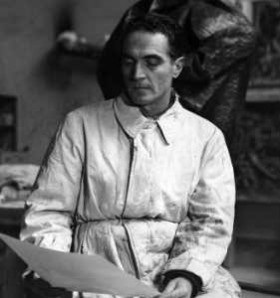Italian sculptor Marino Mazzacurati was a painter and sculptor who practiced in cubism, expressionism and realism. Initially, he lived with his family in Padua and then attended the art academy in Venezia after 1922. From 1926 he studied at the Academy of Arts in Roma and in Paris with Auguste Rodin, and belonged to the modern movement of the Roman School. In 1931, he was the co-founder of the short-lived magazine “Fronte” and illustrated the famous Canti Orfici (Orphic Songs) of the poet Dino Campana. After a few years as a gravestone sculptor in his father’s company, he returned to Roma and took up a professorship. At the beginning of World War II, the expressionistic style of his small sculpture brought him into opposition against the ruling fascist regime. The experiences of war and resistance were also reflected in his works of art. While teaching at the Art Academy in Napoli, Mazzacurati received the National Prize for Sculpture in the 1960s. His sculptures are characterized by a high physical presence with a penchant for grotesque figures. He experimented with metal, stone, wood and ceramics. He also created memorials to the heroes of the resistance in Parma, Napoli, Roma and other Italian cities. His Lottatori (Wrestlers), which he submitted to the Olympic art competitions, marked the start of a new phase of his sculptural work of a crude realism in 1940. Two versions from the series with this title were exhibited in London. One 57 cm high bronze figure from 1940 is today in the Chamber of Deputies in Rome.

 Italy
Italy ITA
ITA